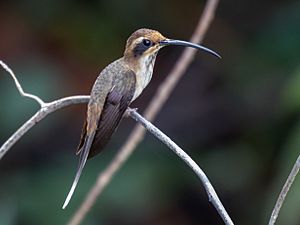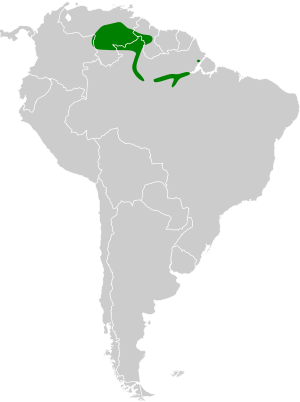Streak-throated hermit facts for kids
Quick facts for kids Streak-throated hermit |
|
|---|---|
 |
|
| Streak-throated hermit at Anavilhanas National Park, Novo Airão, Amazonas state, Brasil | |
| Conservation status | |
| Scientific classification | |
| Genus: |
Phaethornis
|
| Species: |
rupurumii
|
 |
|
The streak-throated hermit (Phaethornis rupurumii) is a small, fast-flying bird called a hummingbird. It's also known as the Rupurumi hermit. These amazing birds live in parts of Brazil, Colombia, Guyana, and Venezuela in South America. They are known for their long, thin beaks and their ability to hover while drinking nectar from flowers.
Contents
About Its Name and Family
Scientists group living things to understand them better. This is called taxonomy. The streak-throated hermit belongs to the hummingbird family, Trochilidae. For a while, some scientists thought it was a type of dusky-throated hermit.
This bird has two main groups, called subspecies. They are P. r. rupurumii and P. r. amazonicus. These two groups live in different places. Some scientists think P. r. amazonicus might even be its own separate species.
What It Looks Like
The streak-throated hermit is a small bird, about 10 to 12.1 centimeters (4 to 4.8 inches) long. It weighs around 2.5 to 3 grams (0.09 to 0.11 ounces), which is very light!
It is mostly brownish, with a greenish back. Its belly is a brownish-gray color. It has a black "mask" around its eyes, like a superhero. It also has white stripes above its eyes and on its cheeks. Its throat is very dark brown and looks streaky. Male and female streak-throated hermits generally look alike.
Where It Lives and Its Home
The main group of streak-throated hermits (P. r. rupurumii) lives in eastern Colombia, central and eastern Venezuela, western Guyana, and northern Brazil. The other group (P. r. amazonicus) lives in north-central Brazil, near the Amazon River.
These hummingbirds like to live in the lower parts of rainforests, especially at the edges. They also live inside várzea forests, which are forests that flood. You can also find them in drier places like semi-deciduous forests (where some trees lose their leaves) and gallery forests (forests along rivers). They also live in scrublands, on river islands, and in secondary forests (forests that have grown back after being cut down). They mostly live in low areas but can be found up to 500 meters (1,600 feet) high in Venezuela and Guyana.
Behavior
Movement
Scientists believe the streak-throated hermit does not move around much. It probably stays in the same area its whole life.
Feeding
The streak-throated hermit eats nectar from flowers. Nectar is a sweet liquid that gives the bird energy. It also eats small arthropods, which are tiny bugs like spiders or insects. We don't know much about how it finds its food.
Reproduction
Not much is known about how the streak-throated hermit builds its nests or raises its young. Scientists are still studying this part of its life.
Vocalization
The streak-throated hermit has a special song. It sings "tsi tsi jéb dé tsi tsi jéb dé" or "eesee-eesee-eesee, eesee-eesee-eesee-swur." It usually sings this song over and over from a low branch near the ground.
Status
The IUCN (International Union for Conservation of Nature) has looked at the streak-throated hermit. They say it is a species of "Least Concern." This means it is not currently in danger of disappearing. We don't know exactly how many of these birds there are or if their numbers are changing. Even though it's not well-known, it seems to be common in some places.
See also
 In Spanish: Ermitaño del Rupununi para niños
In Spanish: Ermitaño del Rupununi para niños


